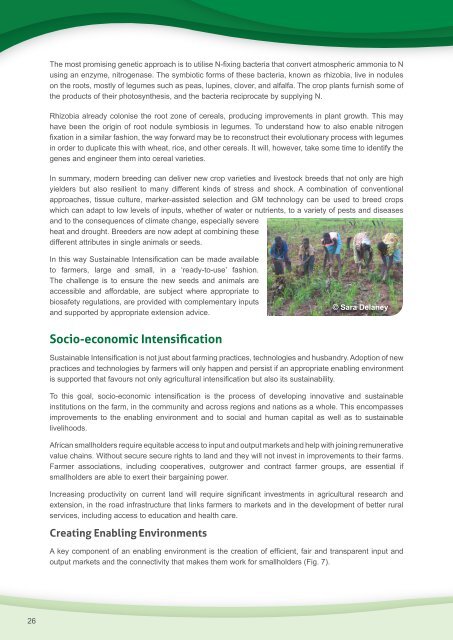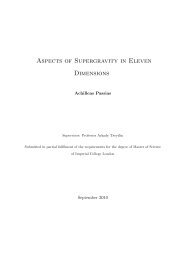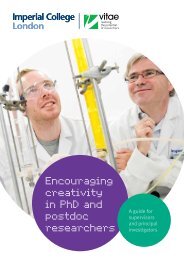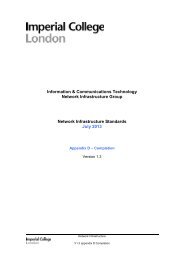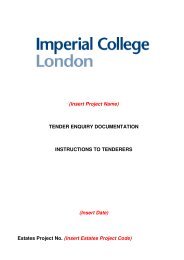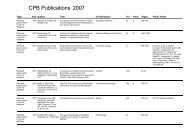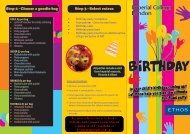Sustainable Intensification: - Workspace - Imperial College London
Sustainable Intensification: - Workspace - Imperial College London
Sustainable Intensification: - Workspace - Imperial College London
Create successful ePaper yourself
Turn your PDF publications into a flip-book with our unique Google optimized e-Paper software.
26<br />
The most promising genetic approach is to utilise N-fixing bacteria that convert atmospheric ammonia to N<br />
using an enzyme, nitrogenase. The symbiotic forms of these bacteria, known as rhizobia, live in nodules<br />
on the roots, mostly of legumes such as peas, lupines, clover, and alfalfa. The crop plants furnish some of<br />
the products of their photosynthesis, and the bacteria reciprocate by supplying N.<br />
Rhizobia already colonise the root zone of cereals, producing improvements in plant growth. This may<br />
have been the origin of root nodule symbiosis in legumes. To understand how to also enable nitrogen<br />
fixation in a similar fashion, the way forward may be to reconstruct their evolutionary process with legumes<br />
in order to duplicate this with wheat, rice, and other cereals. It will, however, take some time to identify the<br />
genes and engineer them into cereal varieties.<br />
In summary, modern breeding can deliver new crop varieties and livestock breeds that not only are high<br />
yielders but also resilient to many different kinds of stress and shock. A combination of conventional<br />
approaches, tissue culture, marker-assisted selection and GM technology can be used to breed crops<br />
which can adapt to low levels of inputs, whether of water or nutrients, to a variety of pests and diseases<br />
and to the consequences of climate change, especially severe<br />
heat and drought. Breeders are now adept at combining these<br />
different attributes in single animals or seeds.<br />
In this way <strong>Sustainable</strong> <strong>Intensification</strong> can be made available<br />
to farmers, large and small, in a ‘ready-to-use’ fashion.<br />
The challenge is to ensure the new seeds and animals are<br />
accessible and affordable, are subject where appropriate to<br />
biosafety regulations, are provided with complementary inputs<br />
and supported by appropriate extension advice.<br />
Socio-economic <strong>Intensification</strong><br />
<strong>Sustainable</strong> <strong>Intensification</strong> is not just about farming practices, technologies and husbandry. Adoption of new<br />
practices and technologies by farmers will only happen and persist if an appropriate enabling environment<br />
is supported that favours not only agricultural intensification but also its sustainability.<br />
To this goal, socio-economic intensification is the process of developing innovative and sustainable<br />
institutions on the farm, in the community and across regions and nations as a whole. This encompasses<br />
improvements to the enabling environment and to social and human capital as well as to sustainable<br />
livelihoods.<br />
African smallholders require equitable access to input and output markets and help with joining remunerative<br />
value chains. Without secure secure rights to land and they will not invest in improvements to their farms.<br />
Farmer associations, including cooperatives, outgrower and contract farmer groups, are essential if<br />
smallholders are able to exert their bargaining power.<br />
Increasing productivity on current land will require significant investments in agricultural research and<br />
extension, in the road infrastructure that links farmers to markets and in the development of better rural<br />
services, including access to education and health care.<br />
Creating Enabling Environments<br />
© Sara Delaney<br />
A key component of an enabling environment is the creation of efficient, fair and transparent input and<br />
output markets and the connectivity that makes them work for smallholders (Fig. 7).


